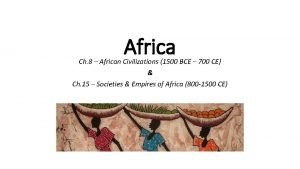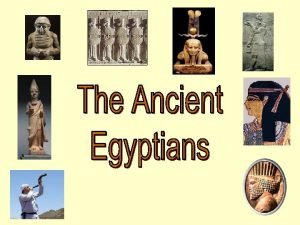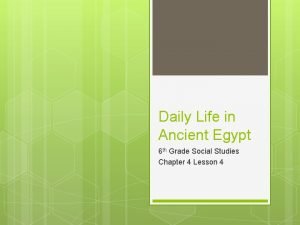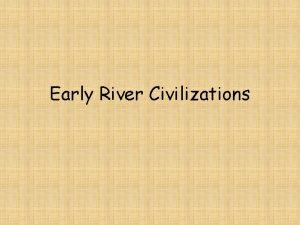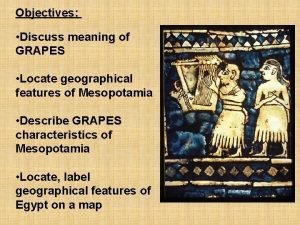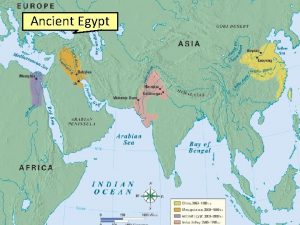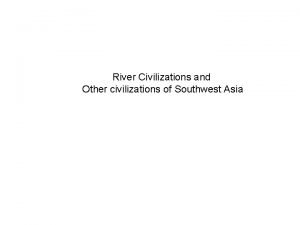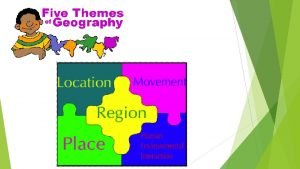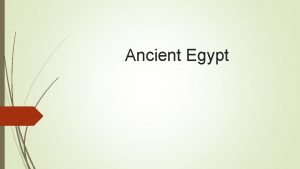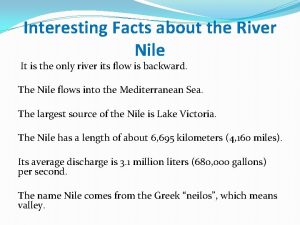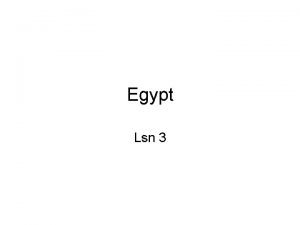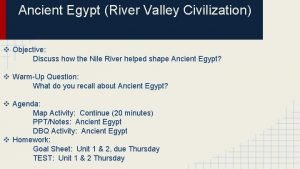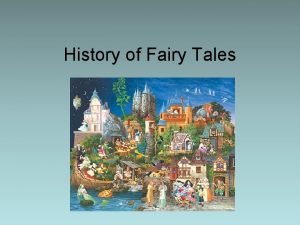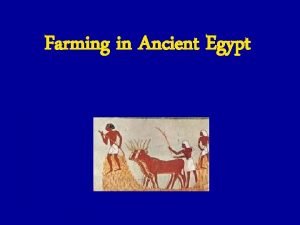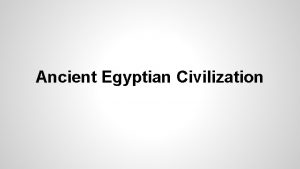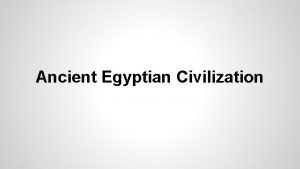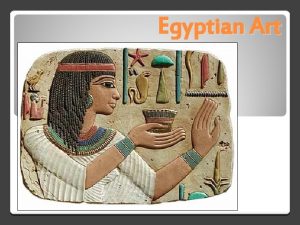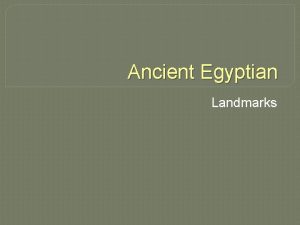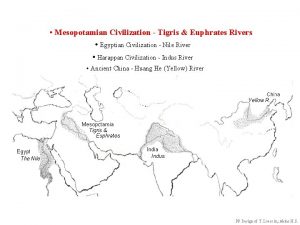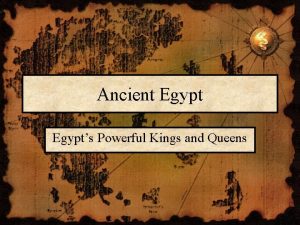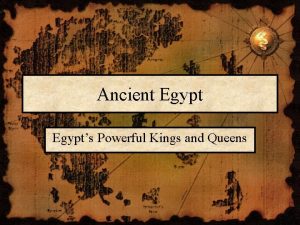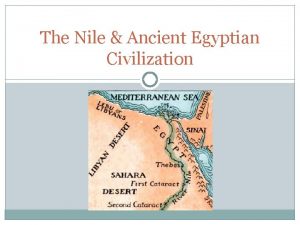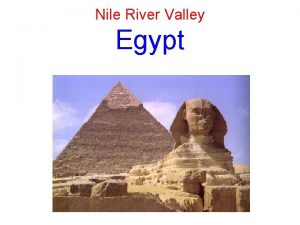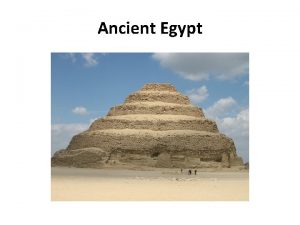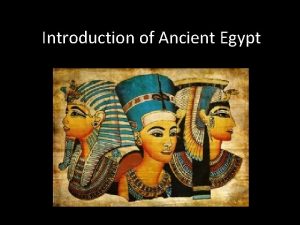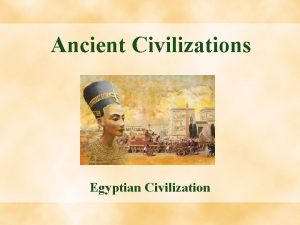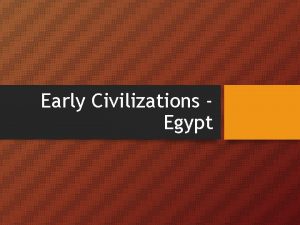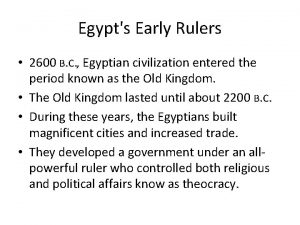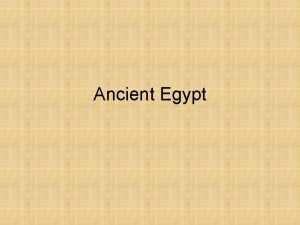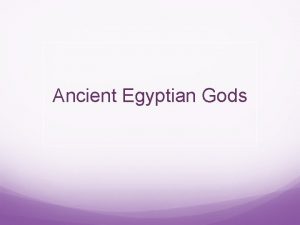Ancient Egyptian Civilization Geography NILE RIVER Egypts settlements
































- Slides: 32

Ancient Egyptian Civilization

Geography NILE RIVER Egypt’s settlements arose along narrow strip of land made fertile by the river Yearly flooding, but predictable Regular cycle: flood, plant, harvest, flood, plant, harvest Intricate network of irrigation ditches Worshiped as a god – giver of life and benevolent

Question How did the geographic factors help to fortify the Egyptian civilization? How did the geographic conditions of the early Egyptian Civilization compare to that of the early Mesopotamian city-states?

Geography Upper and Lower Egypt Most of Egypt’s history focused around Lower Egypt, around the Nile delta which flows into the Mediterranean Sea. Upper Egypt developed later upstream. Nile provided reliable transportation - to go north, drift with the current toward the sea - to go south, sail catching the Mediterranean breeze

Environment Unlike Mesopotamia, the Nile was predictable Deserts on both sides of Nile - provided natural protection against invaders - also reduced interaction with other people Egypt would develop mostly in isolation and therefore, a culture that was quite unique.

Analyze/ Interpret the Artifact Please analyze and interpret the two tablets. All you know is the following information: - tablets were created during the earliest days of the Ancient Egyptian civilization - tablets tell a story of a significant historical event - tablets 1 tells the beginning of the story and tablet 2 tells the end

Early Government UNITED EGYPT’S GOVERNMENT Unlike Sumeria, no independent city-states in Egypt Menes, the king of Upper Egypt, - united the two regions – Upper and Lower – in 3, 100 B. C. E. - Capital: Memphis - Creates first Egyptian dynasty The Pharaoh [means, royal house] – the ruler of Egypt were considered gods; served both political and religious roles Type of government where the political rulers are thought to be divinely-guided, or even divine themselves is a theocracy.

Narmer Palette The Narmer Palette, also known as the Great Hierakonpolis Palette or the Palette of Narmer significant Egyptian archeological find, dating from about the 31 st century BC containing some of the earliest hieroglyphic inscriptions ever found depict the unification of Upper and Lower Egypt under the king Narmer (Menes) On one side, the king is depicted with the bulbed White Crown of Upper (southern) Egypt, and the other side depicts the king wearing the level Red Crown of Lower (northern) Egypt. The Palette, which has survived five millennia in almost perfect condition was discovered by British archeologists James E. Quibell and Frederick W. Green, in what they called the Main Deposit in the Temple of Horus at Nekhen, during the dig season of 1897– 1898.

Narmer Palette In his right hand the king wields a mace, ready to smash the skull of a kneeling man (possibly a Libyan) whom he holds by the hair with his left hand. The name of this kneeling man (wash) written in hieroglyphs above his head suggests that he may have been important or that it may be referring to a group of people. Above the victim's head and in front of Narmer's face, the falcon Horus of Nekhen symbol of Egyptian royalty and protector of the king - is sitting upon the plants of a personified papyrus marshland. The papyrus blossom in early hieroglyphs stands for the numeral one thousand - this group therefore means that the king had captured six thousand enemies. This is frequently used to symbolise Lower Egypt. Therefore the meaning of this part of the scene is quite clear : the Upper Egyptian king tramples the Lower Egyptian marshlands.

Narmer Palette The association of Hathor, usually represented with inwards horns, and as mother of the king is seen in most of the Egyptian art and literature. On the left hand side of the top level, the king, followed by a smaller figure carrying his sandals - known as the Sandal Bearer - is represented wearing the Red Crown of Lower Egypt. The entire procession is walking towards ten decapitated bodies - divided in two rows of five persons each, lying on the ground, with their disembodied heads between their legs. They represent the king's vanquished enemies. The two felines are often interpreted as the two parts of the country tied together, since they symbolise harmony and unity. In the bottom scene, the symbolism of this scene is made clear : the bull represents the king's masculinity and vigorous power, while destroying his enemies with the force of a strong bull.

Question: How did the leadership of Ancient Egypt compare to the Sumerian city-states?

How do these religious images compare?

Religion Syncretism The image of the goddess Isis holding her child Horus was common throughout Egypt and is similar to Mary holding Jesus Christ If fact, the early Christians had an easy time marketing their new Roman religion to the Egyptians - particularly after convincing them that Mary, mother of Jesus, was an incarnation of Isis! Religious Syncretism: fusion (or combination) of differing systems of belief, as in philosophy or religion

Religious Beliefs Believed each pharaoh ruled even after death they all possessed the same eternal spirit = ka; and being gods, they naturally bore full responsibility for Egypt’s well-being. Therefore, Pharaoh’s tomb very important, because it was still a place of rule. Built massive tombs called pyramids. The pyramids were built mainly in the Old Kingdom Period Polytheistic - WHAT DOES THIS MEAN?

Religion Polytheistic Over 2, 000 gods Ra, the sun god; Horus, sky god; Isis, mother goddess “giver of life” associated with Nile

Religion: Afterlife The Funerary Scene: This scene depicts what occurs after a person has died, according to the ancient Egyptians. The Egyptians had an elaborate and complex belief in the afterlife.

Religion: Afterlife Belief in afterlife! The dead were judged by Osiris, god of the dead. Osiris would weigh each person’s heart on a scale against the weight of a feather. If the heart tipped the scale, heavy with sin, the Devourer of Souls would pounce on the heart. If not, the soul would live forever in the Other World.

Afterlife Desiring to make it to the Other World safely, Egyptians of all classes made special preparations for their burials, including mummification – embalming and preserving the corpse to prevent it from decaying. Canopic jars for the body’s various organs. Coffin of a Middle Kingdom government official.

Do Now: Please answer the questions below independently and then compare/contrast your responses with a partner. 1)What is a value system? 2)What are some of your personal values?

Definition Value System: the system of established values, norms, or goals existing in a society Why are value systems so important to society? How are value systems spread among civilization?

Do Now: Please take out the chart on gods and goddesses and name three values that you identified based on what they represented.

Relief from the Tomb of Mentuemhet

Social Structure Royal Family Upper class Landowners Priests Army commanders Government officials Middle Class (merchants / artisans) Lower class (peasant farmers, unskilled laborers) Right: Wealthy man’s house at Amarna.

Social Structure Socially Mobile classes Not “locked in”, lower and middle classes could rise up through marriage or through merit (success) A. Harvesting grain; B. Musicians play for the workers in the fields; C. Women winnowing the grain; D. Scribes tally the farmer’s taxes; E. The farmer’s son tending the livestock / cattle.

Women’s Rights Women had many of the same rights as men: could own property could seek divorce enter the priesthood served as doctors Did you know… Men and women wore makeup in Egypt. The dark-lined eyes that look out at us from the artwork of ancient Egypt was the height of fashion and was called kohl – powdered minerals mixed with water and applied with a small stick. Both genders also wore lipstick – crushed red ocher (iron oxide) mixed with oil.

Hieroglyphics Pictographs developed into hieroglyphics: written on Papyrus, unfurled reed from the Nile, dried into strips The Rosetta Stone, discovered in 1799 A. D. Why was the knowledge of reading hieroglyphics LOST in the first place? In the first century A. D. when Christianity arrived in Egypt, it was common for the Christian movement to remove / destroy the religious images, writings, and priesthood of the former religion in the region. During this chaotic time of transition, the literate priests and scribes were mostly killed off and the knowledge of hieroglyphics was lost for almost 1, 500 years.

Rosetta Stone The Rosetta Stone (carved in 196 BC and found in 1799) is written in three scripts because there were three scripts being used in Egypt. The first was hieroglyphic which was the script used for important or religious documents. The second was demotic which was the common script of Egypt. The third was Greek which was the language of the rulers of Egypt at that time.

Advances in Technology and Science Developed certain geometric concepts and a numeric system on base 10 (decimal) Engineers and architects advanced buildings (first to use stone columns) Developed a calendar that became the basis of our modern calendar Advancements in medicine-including simple non-invasive surgery, setting of bones and an extensive set of pharmacopoeia (learned through mummification) Knowledge of Nutrition (all classes had access to a variety of food)

Question How could being geographically isolated both help and hinder the development of civilization?

Other Achievements Wigs Sun and Water Clock Surgical Instruments Ox-drawn plow Solar Calendar Papyrus Sheets

Question How did Egyptian social structure lead to the civilization making progress/advancements?

Fall of Ancient Egypt INVASIONS A. Old Kingdom begins to decline, ca. 2180 B. C. E. After about a century of fragmented and weak rulers, B. Middle Kingdom period rises [2080 -1640 B. C. E. ] - Center of power is now in Thebes in Upper Egypt rather than Lower Egypt’s old Memphis capital. - This is a prosperous period. Massive building projects around Thebes. Unfortunately the Egyptians took their years of well-protected geographic isolation for granted and made little real defensive preparations should the unthinkable happen The unthinkable happened. Invaded by the Hyksos, an Asiatic people, great chariot-riders – which they introduced in Egypt for the first time. These foreigners bring the Middle Kingdom period to an end and will rule Egypt for 70 years
 Colonial williamsburg floral design time period
Colonial williamsburg floral design time period What lasting legacies did the aksum kingdom leave
What lasting legacies did the aksum kingdom leave Riverrock funds
Riverrock funds Why were ancient greek communities isolated from each other
Why were ancient greek communities isolated from each other Ancient egypt civilization geography
Ancient egypt civilization geography Multiple nuclei model definition geography
Multiple nuclei model definition geography Geography grade 12 settlement questions and answers
Geography grade 12 settlement questions and answers Egypts social pyramid
Egypts social pyramid Egypts middle kingdom
Egypts middle kingdom Absolute location of egypt
Absolute location of egypt Tigris euphrates and nile river
Tigris euphrates and nile river The picture tell us that
The picture tell us that Geographic features of mesopotamia
Geographic features of mesopotamia Nile river
Nile river Nile river
Nile river Frontalism definition
Frontalism definition Relative location of nile river
Relative location of nile river Cataracts of the nile map
Cataracts of the nile map Ancient egypt advanced cities
Ancient egypt advanced cities What model is it
What model is it Nile river basin
Nile river basin A section of the nile river with rapids and rocky terrain
A section of the nile river with rapids and rocky terrain Interesting facts about river nile
Interesting facts about river nile Wheres the yellow river
Wheres the yellow river The nile river is the lifeline of
The nile river is the lifeline of Kush nile river
Kush nile river Lego shaduf
Lego shaduf How did the nile shape ancient egypt essay
How did the nile shape ancient egypt essay How did the nile shape ancient egypt dbq answer key
How did the nile shape ancient egypt dbq answer key How long egyptian civilization lasted
How long egyptian civilization lasted Kalasiris
Kalasiris Image
Image What crops did egypt grow
What crops did egypt grow

